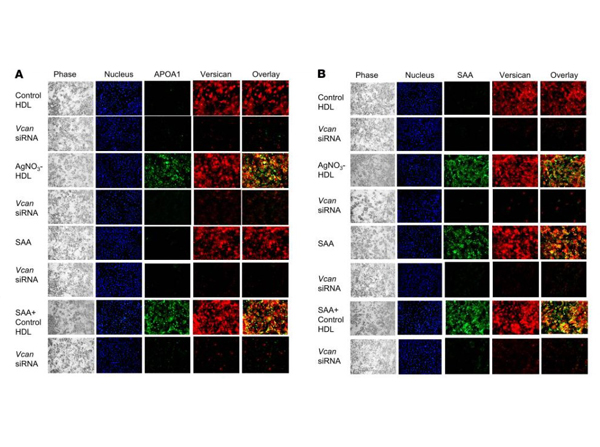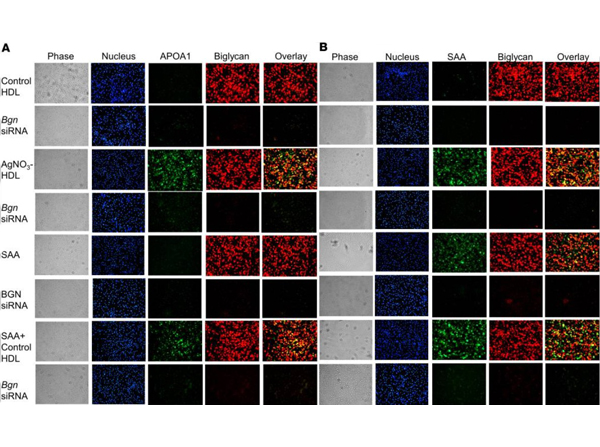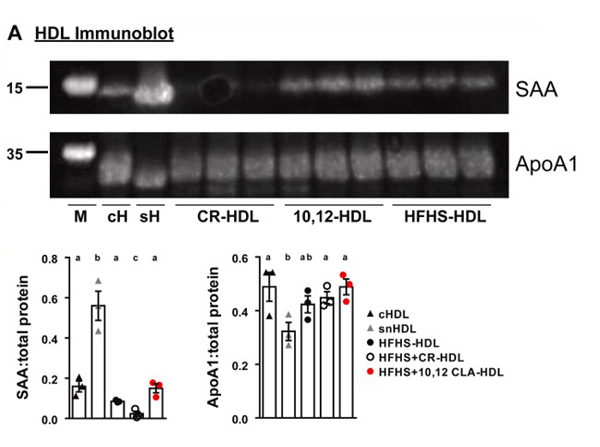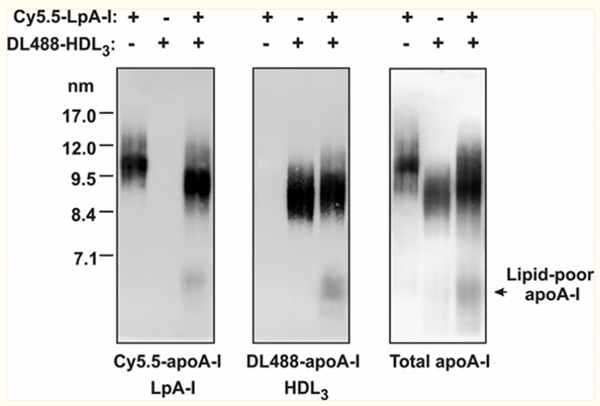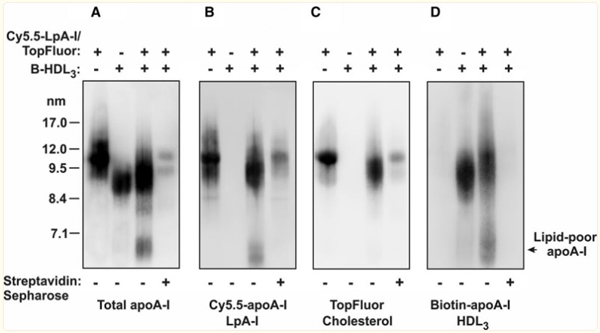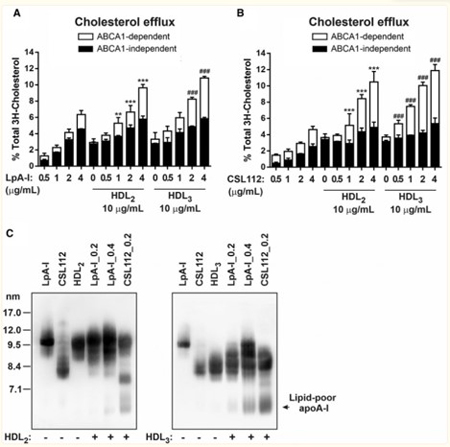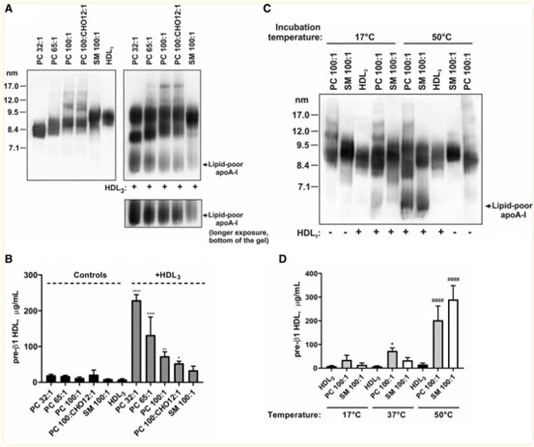Apolipoprotein A-I Antibody
Goat Polyclonal
17 References
600-101-196
1 mg
Liquid (sterile filtered)
WB, ELISA, IHC, IF, Other
Mouse
Goat
Shipping info:
$50.00 to US & $70.00 to Canada for most products. Final costs are calculated at checkout.
Product Details
Anti-Apolipoprotein A-I (GOAT) Antibody - 600-101-196
goat anti-Apolipoprotein A-I Antibody, goat anti-APOA1 antibody, goat anti-APO-A1 antibody, goat anti-APOA-1 antibody, APOA1/APOC3 fusion gene antibody, Apolipoprotein A I precursor antibody, Apolipoprotein AI antibody, Apolipoprotein of high density lipoprotein antibody, ProapoA-I, Proapolipoprotein A-I
Goat
Polyclonal
IgG
Target Details
Apoa1 - View All Apoa1 Products
Mouse
Native Protein
apoLipoprotein Type A-I was isolated from mouse plasma by density gradient centrifugation followed by HPLC purification.
This product has been prepared by immunoaffinity chromatography using immobilized antigens followed by extensive cross-adsorption against other apoLipoproteins and human serum proteins to remove any unwanted specificities. Typically less than 1% cross-reactivity against other types of apoLipoprotein was detected by ELISA against purified standards. This antibody reacts with mouse apoLipoprotein A-I and has negligible cross-reactivity with Type A-II, B, C-I, C-II, C-III, E and J apoLipoproteins. Specific cross-reaction of anti-apoLipoprotein antibodies with antigens from other species has not been determined. Non-specific cross-reaction of anti-apoLipoprotein antibodies with other mouse serum proteins is negligible.
Application Details
ELISA, IF, IHC, Other, WB
- View References
Anti-apoLipoprotein antibodies have been used for indirect trapping ELISA for quantitation of antigen in serum using a standard curve, for immunoprecipitation and for western blotting for highly sensitive qualitative analysis.
Formulation
1.0 mg/mL by UV absorbance at 280 nm
0.125 M Sodium Borate, 0.075 M Sodium Chloride, 0.005 M EDTA, pH 8.0
0.01% (w/v) Sodium Azide
None
Shipping & Handling
Wet Ice
Store vial at 4° C prior to opening. This product is stable at 4° C as an undiluted liquid. Dilute only prior to immediate use. For extended storage, mix with an equal volume of glycerol, aliquot contents and freeze at -20° C or below. Avoid cycles of freezing and thawing.
Expiration date is one (1) year from date of receipt.
Anti Apolipoprotein A-I antibody recognizes the gene product of APOA1. Apolipoprotein promotes cholesterol efflux from tissues to the liver for excretion. Apolipoprotein A-I is the major protein component of high density lipoprotein (HDL) in the plasma. Synthesized in the liver and small intestine, it consists of two identical chains of 77 amino acids; an 18-amino acid signal peptide is removed co-translationally and a 6-amino acid propeptide is cleaved post-translationally. Variation in the latter step, in addition to modifications leading to so-called isoforms, is responsible for some of the polymorphism observed. APOA1 is a cofactor for lecithin cholesterolacyltransferase (LCAT) which is responsible for the formation of most plasma cholesteryl esters. The APOA1, APOC3 and APOA4 genes are closely linked in both rat and human genomes. The A-I and A-IV genes are transcribed from the same strand, while the C-III gene is transcribed convergently in relation to A-I. Defects in the apolipoprotein A-1 gene are associated with HDL deficiency and Tangier disease. This antibody is suitable for cardiovascular research.
Vaisar, T et al. (2022). 10,12-Conjugated linoleic acid supplementation improves HDL composition and function in mice. Journal of Lipid Research
Applications
WB, IB, PCA
Shimizu-Albergine M et al. (2021). CREBH normalizes dyslipidemia and halts atherosclerosis in diabetes by decreasing circulating remnant lipoproteins. J Clin Invest.
Applications
IHC, ICC, Histology
Han CY et al. (2020). Serum amyloid A–containing HDL binds adipocyte-derived versican and macrophage-derived biglycan, reducing its antiinflammatory properties. JCI Insight.
Applications
IF, Confocal Microscopy; IHC, ICC, Histology
Navdaev AV. et al. (2020). Nascent HDL (High-Density Lipoprotein) Discs Carry Cholesterol to HDL Spheres. Effects of HDL Particle Remodeling on Cholesterol Efflux. Arteriosclerosis, Thrombosis, and Vascular Biology
Applications
WB, IB, PCA; IF, Confocal Microscopy
Han et al. (2016). Serum amyloid A impairs the antiinflammatory properties of HDL. Journal of Clinical Investigation
Applications
IHC, ICC, Histology
Toth ME et al. (2013). Overexpression of Hsp27 ameliorates symptoms of Alzheimer's disease in APP/PS1 mice. Cell Stress Chaperones.
Applications
WB, IB, PCA
Fitz NF et al. (2012). Abca1 deficiency affects Alzheimer's disease-like phenotype in human ApoE4 but not in ApoE3-targeted replacement mice. J Neurosci.
Applications
E, EIA
Champy MF et al. (2011). Reduced body weight in male Tspan8-deficient mice. Int J Obes (Lond).
Applications
E, EIA
Tadin-Strapps M et al. (2011). siRNA-induced liver ApoB knockdown lowers serum LDL-cholesterol in a mouse model with human-like serum lipids. J Lipid Res.
Applications
E, EIA
Dossing K et al. (2009). Apolipoprotein B epitopes are present in nuclear preparations of human and mouse cells. Int J mol Med.
Applications
WB, IB, PCA
Cen X et al. (2009). An apoA-I mimetic peptide increases LCAT activity in mice through increasing HDL concentration. Int J Biol Sci.
Applications
E, EIA; WB, IB, PCA
Hu W et al. (2008). Biogenesis of HDL by SAA is dependent on ABCA1 in the liver in vivo. J Lipid Res.
Applications
qRT-PCR, RT-PCR; WB, IB, PCA
Mihovilovic M et al. (2007). High-fat/high-cholesterol diet promotes a S1P receptor-mediated antiapoptotic activity for VLDL. J Lipid Res.
Applications
Bead Conjugation; Incubation
van der Hoogt CC et al. (2007). Fenofibrate increases HDL-cholesterol by reducing cholesteryl ester transfer protein expression. J Lipid Res.
Applications
E, EIA
de Haan W et al. (2007). Atorvastatin increases HDL cholesterol by reducing CETP expression in cholesterol-fed APOE* 3-Leiden. CETP mice. Atherosclerosis.
Applications
E, EIA
Lefterov I et al. (2007). Expression profiling in APP23 mouse brain: inhibition of Abeta amyloidosis and inflammation in response to LXR agonist treatment. Molecular Neurodegeneration
Applications
WB, IB, PCA
Allen E et al. (2006). Loss of polycystin-1 or polycystin-2 results in dysregulated apolipoprotein expression in murine tissues via alterations in nuclear hormone receptors. Hum Mol Genet.
Applications
WB, IB, PCA
This product is for research use only and is not intended for therapeutic or diagnostic applications. Please contact a technical service representative for more information. All products of animal origin manufactured by Rockland Immunochemicals are derived from starting materials of North American origin. Collection was performed in United States Department of Agriculture (USDA) inspected facilities and all materials have been inspected and certified to be free of disease and suitable for exportation. All properties listed are typical characteristics and are not specifications. All suggestions and data are offered in good faith but without guarantee as conditions and methods of use of our products are beyond our control. All claims must be made within 30 days following the date of delivery. The prospective user must determine the suitability of our materials before adopting them on a commercial scale. Suggested uses of our products are not recommendations to use our products in violation of any patent or as a license under any patent of Rockland Immunochemicals, Inc. If you require a commercial license to use this material and do not have one, then return this material, unopened to: Rockland Inc., P.O. BOX 5199, Limerick, Pennsylvania, USA.

